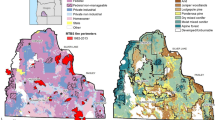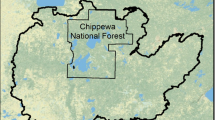Abstract
While ecosystem services and climate change are often examined independently, quantitative assessments integrating these fields are needed to inform future land management decisions. Using climate-informed state-and-transition simulations, we examined projected trends and tradeoffs for a suite of ecosystem services under four climate change scenarios and two management scenarios (active management emphasizing fuel treatments and no management other than fire suppression) in a fire-prone landscape of dry and moist mixed-conifer forests in central Oregon, USA. Focal ecosystem services included fire potential (regulating service), timber volume (provisioning service), and potential wildlife habitat (supporting service). Projections without climate change suggested active management in dry mixed-conifer forests would create more open forest structures, reduce crown fire potential, and maintain timber stocks, while in moist mixed-conifer forests, active management would reduce crown fire potential but at the expense of timber stocks. When climate change was considered, however, trends in most ecosystem services changed substantially, with large increases in wildfire area predominating broad-scale trends in outputs, regardless of management approach (e.g., strong declines in timber stocks and habitat for closed-forest wildlife species). Active management still had an influence under a changing climate, but as a moderator of the strong climate-driven trends rather than being a principal driver of ecosystem service outputs. These results suggest projections of future ecosystem services that do not consider climate change may result in unrealistic expectations of benefits.





Similar content being viewed by others
References
Adams MA (2013) Mega-fires, tipping points and ecosystem services: managing forests and woodlands in an uncertain future. For Ecol Manag 294:250–261
Apex and ESSA (2011) Path landscape model online documentation. Apex Resource Management Solutions Ltd. and ESSA Technologies Ltd, Ottawa, http://www.apexrms.com
Bachelet D, Lenihan J, Daly C et al (2001) MC1: a dynamic vegetation model for estimating the distribution of vegetation and associated carbon, nutrients, and water - technical documentation. Version 1.0. Gen. Tech. Rep. PNW-GTR-508. Portland, OR: U.S. 95 p.
Bachelet D, Ferschweiler K, Sheehan TJ et al (2015) Projected carbon stocks in the conterminous USA with land use and variable fire regimes. Glob Change Biol 21:4548-4560
Case MJ, Lawler JJ, Tomasevic JA (2015) Relative sensitivity to climate change of species in northwestern North America. Biol Conserv 187:127-133
Daly C, Halbleib M, Smith JI et al (2008) Physiographically sensitive mapping of climatological temperature and precipitation across the conterminous United States. Int J Climatol 28:2031–2064
Daniel CJ, Frid L (2012) Predicting landscape vegetation dynamics using state-and-transition simulation models. In: Kerns BK, Shlisky AJ, Daniel CJ (eds) Proceedings of the First Landscape State-and-Transition Simulation Modeling Conference, Portland, OR, USA, 14–16 June 2011, pp 5–22.
Earles JM, North MP, Hurteau MD (2014) Wildfire and drought dynamics destabilize carbon stores of fire-suppressed forests. Ecol Appl 24:732–740
Elkin C, Gutiérrez AG, Leuzinger S et al (2013) A 2 °C warmer world is not safe for ecosystem services in the European Alps. Glob Chang Biol 19:1827–1840
Federal Register. 2012. 36 CFR Part 219. RIN 0596-AD02. National Forest System land management planning, final rule and record of decision. 77:21162–21276. Washington, DC: U.S. Department of Agriculture, Forest Service
Fischlin A, Midgley GF, Price JT et al (2007) Ecosystems, their properties, goods, and services. In: Parry ML, Canziani OF, Palutikof JP et al (eds) Climate change 2007: impacts, adaptation and vulnerability. Contribution of Working Group II to the Fourth Assessment Report of the Intergovernmental Panel on Climate. Cambridge University Press, Cambridge, pp 211–272
Fowler HJ, Blenkinsop S, Tebaldi C (2007) Linking climate change modeling to impacts studies: recent advances in downscaling techniques for hydrological modeling. Int J Climatol 27:1547–1578
Gordon HB, Rotstayn JL, McGregor MR et al (2002) The CSIRO Mk3 climate system model. CSIRO Atmospheric Research technical paper no. 60. CSIRO Atmospheric Research
Groffman PM, Kareiva P, Carter S et al (2014) Ch. 8: ecosystems, biodiversity, and ecosystem services. In: Melillo JM, Richmond TC, Yohe GW (eds) Climate change impacts in the United States: the Third National Climate Assessment. U.S. Global Change Research Program, pp 195–219
Halofsky JE, Hemstrom MA, Conklin DR et al (2013) Assessing potential climate change effects on vegetation using a linked model approach. Ecol Model 266:131–143
Halofsky JS, Halofsky JE, Burcsu T et al (2014a) Potential effects of climate change and management in dry forests of central Oregon. Ecol Appl 24:1908–1925
Halofsky JE, Creutzburg, MK, Hemstrom, MA (eds) (2014a) Integrating social, economic, and ecological values across large landscapes. Gen. Tech. Rep. PNW-GTR-896. Portland, OR: U.S. Department of Agriculture, Forest Service, Pacific Northwest Research Station. 206 p
Hasumi H, Emori S (eds) (2004) K-1 coupled model (MIROC) description. Technical Report 1. University of Tokyo, Center for Climate System Research, Tokyo, Japan
Henderson JA, Lesher RD, Peter DH, Ringo CD (2011) A landscape model for predicting potential natural vegetation of the Olympic Peninsula USA using boundary equations and newly developed environmental variables. Gen. Tech. Rep. PNW-GTR-841. Portland, OR: U.S. Department of Agriculture, Forest Service, Pacific Northwest Research Station. 35 p
Hessburg PF, Spies TA, Perry DA et al (2016) Tamm review: management of mixed-severity fire regime forests in Oregon, Washington, and Northern California. For Ecol Manag. In press
IPCC [Intergovernmental Panel on Climate Change] (2007) Contribution of Working Group I to the Fourth Assessment Report of the Intergovernmental Panel on Climate Change. In: Solomon S, Qin D, Manning M, Chen Z et al (eds) Cambridge University Press. Cambridge, United Kingdom and New York, New York, USA
Johns TC, Gregory JM, Ingram WJ et al (2003) Anthropogenic climate change for 1860 to 2100 simulated with the HadCM3 model under updated emissions scenarios. Clim Dyn 20:583–612
Littell JS, Oneil EE, McKenzie D et al (2010) Forest ecosystems, disturbance, and climatic change in Washington State, USA. Climatic Change 102:129-158
Maes J, Paracchini ML, Zulian G et al (2012) Synergies and trade-offs between ecosystem service supply, biodiversity, and habitat conservation status in Europe. Biol Conserv 155:1–12
Merschel AG, Spies TS, Heyerdahl EK (2014) Mixed-conifer forests of central Oregon: effects of logging and fire exclusion vary with environment. Ecol Appl 24:1670–1688
Millar CI, Stephenson NL (2015) Temperate forest health in an era of emerging megadisturbance. Science 349:823–826
Millennium Ecosystem Assessment (2005) Living beyond our means: natural assets and human well-being. Island Press, Washington, D.C
Mina M, Bugmann H, Cordonnier T et al (2016) Future ecosystem services from European mountain forests under climate change. J Appl Ecol. doi:10.1111/1365-2664.12772
Montoya JM, Raffaelli D (2010) Climate change, biotic interactions and ecosystem services. Philos T Roy Soc B 365:2013-2018
Morelli TL, Daly C, Dobrowski SZ et al (2016) Managing climate change refugia for climate adaptation. PLoS One 11: p.e0159909
Nakićenović N, Swart R (eds) (2000) Special report on emissions scenarios. A special report of Working Group III of the Intergovernmental Panel on Climate Change. Cambridge University Press, Cambridge
Ohmann J, Gregory MJ (2002) Predictive mapping of forest composition and structure with direct gradient analysis and nearest neighbor imputation in coastal Oregon, U.S.A. Can J Forest Res 32:725–741
PRISM Group (2012) Parameter-elevation Regressions on Independent Slopes Model climate mapping system [online]. http://www.prism.oregonstate.edu/
Qiu J, Turner MG (2013) Spatial interactions among ecosystem services in an urbanizing agricultural watershed. Proc Natl Acad Sci U S A 110:12149–12154
Rocca ME, Brown PM, MacDonald LH et al (2014) Climate change impacts on fire regimes and key ecosystem services in Rocky Mountain forests. Forest Ecol Manag 327:290-305
Rogers BM, Neilson RP, Drapek et al (2011) Impacts of climate change on fire regimes and carbon stocks of the U.S. Pacific Northwest. J Geophys Res 116:G03037
Seidl R, Spies TA, Peterson DL et al (2016) Searching for resilience: addressing the impacts of changing disturbance regimes on forest ecosystem services. J Appl Ecol 53:120–129
Stephens SL, Burrows N, Buyantuyev A et al (2014) Temperate and boreal forest mega-fires: characteristics and challenges. Front Ecol Environ 12:115–122
Stavros EN, Abatzoglou JT, McKenzie D et al (2014) Regional projections of the likelihood of very large wildland fires under a changing climate in the contiguous Western United States. Climatic Change 126:455-468
Stine, P, Hessburg, P, Spies, T, et al (2014) The ecology and management of moist mixed-conifer forests in eastern Oregon and Washington: a synthesis of the relevant biophysical science and implications for future land management. Gen. Tech. Rep. PNW-GTR-897. Portland, OR: U.S. 254 p.
Tempereli C, Bugmann H, Elkin C (2012) Adaptive management for competing forest goods and services under climate change. Ecol Appl 22:2065–2077
Acknowledgements
We thank J. Barbour, A. Brodie, and A. Estep for project support, D. Bachelet and D. Conklin for running MC1, J. Campbell for manuscript improvements, and thoughtful comments from two anonymous reviewers. This work was conducted as part of the Integrated Landscape Assessment Project, which was funded by the American Recovery and Reinvestment Act, the USDA Forest Service Pacific Northwest Research Station, the USDA Forest Service Pacific Northwest Region, and the USDA Forest Service Southwest Region. Any opinions, findings, and conclusions or recommendations expressed in this material are those of the author(s) and do not necessarily reflect the views of the funding or parent organization(s).
Author information
Authors and Affiliations
Corresponding author
Electronic supplementary material
Below is the link to the electronic supplementary material.
ESM 1
(DOCX 34 kb)
Rights and permissions
About this article
Cite this article
Halofsky, J.S., Halofsky, J.E., Hemstrom, M.A. et al. Divergent trends in ecosystem services under different climate-management futures in a fire-prone forest landscape. Climatic Change 142, 83–95 (2017). https://doi.org/10.1007/s10584-017-1925-0
Received:
Accepted:
Published:
Issue Date:
DOI: https://doi.org/10.1007/s10584-017-1925-0




